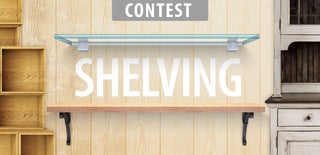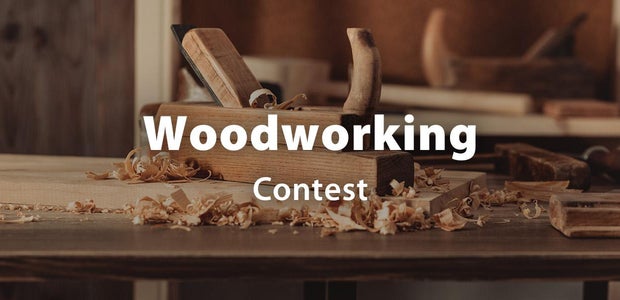Introduction: Rustic Shelf With Hammer Head Hooks
In this Instructable I make a rustic shelf with hammer heads for the clothes hooks. I thought about making this out of a nicer wood but I had some leftover pallet wood and decided to use it instead. If I don’t like it I can always unscrew the hammer heads and attach them to a nicer shelf. I purchased the hammers awhile ago at Harbor Freight for around $3-$4 ea. I bought them because they were cheap and thought I could use them for something other than their intended use. I didn’t have a set design or plan for these I just put it together as I went along. There were no major issues except for the split wood. That was something I should have fixed before I glued and screwed it on to the back. This is also the first time I tried adding a hammered texture to metal which I feel really added to the overall look of the piece. If I were to make this again I would probably add something to the bottom edge it feels like it is missing something but I don’t have any ideas at the moment.
Build video.
Step 1:
These are the three hammer heads that I used for this project. As I said in the intro I bought these for about $3-$4 each at the time, which I don't consider terribly expensive considering what "nice" coat hooks can cost.
Step 2:
The first thing I did was cut off the hammer heads. I setup a stop block on my miter saw and cut off the handle at what I thought looked like the right length. I probably should have put some type of spacer in the gap under the handle to support the piece while I made the cuts. In the end this didn't affect the cuts but it probably would have been safer.
Step 3:
I didn't have an actual plan for the shelf so I just tried a few different things placing the wood in various configurations until I found one that I liked. I also played around with the positioning of the hammer heads to see what looked best. At this point nothing is glued or screwed.
Step 4:
Since this is pallet wood I didn't measure the lengths to cut, instead I just placed each piece where it would be attached and marked where I would need to make the cut. The pallet wood is far from perfect and it is easier and probably more accurate to mark the cut then measure it.
Step 5:
I used a square to transfer the mark across the front of the board and used my miter saw to make the cut for all three pieces.
Step 6:
After making the cuts I check the fit again and then added glue to the vertical pieces and then placed the horizontal pieces on top of them.
Step 7:
Next I pre-drill all the pilot holes and screwed the horizontal pieces to the vertical ones.
Step 8:
Its the same process for the center vertical piece. I find the center of all the pieces and then add glue making sure to pre-drill pilot holes and then finally add the screws.
Step 9:
Next it was time to add the piece on top that would make the shelf. I added glue to the top edges and here again made sure to pre-drill pilot holes and attach the shelf with screws. I used a clamp to hold the shelf in place while I screwed it together. The last picture shows what the shelf looks like from the top once it has been screwed.
Step 10:
I should have fixed this crack before screwing the shelf to the rest of the piece. It was a simple fix I just added glue to the crack and used a brush to shove the glue in to the crack and then clamped it for 24 hours to let the glue dry. The cracks add to the rustic look.
Step 11:
I didn't think the top shelf joint was very strong so I added some metal support pieces. This is just some 1/2 inch wide mild steel that I cut to length. Here again I didn't use a tape measure to get the length I just held the steel up to the two corners and marked where I would make the cut. I used my angle grinder fitted with a cut off wheel to make the cuts.
Step 12:
I felt the steel bracing looked a little too new and decided to add some character to the metal. So I took my ball peen hammer and began randomly hammering the entire surface of the steel, front and back. After quite a bit of hammering I got the look I was after.
Step 13:
I used my belt sander to round over the edges.
Step 14:
After rounding over the edges I marked where the screw holes would go and center punched the marks and then drilled the four holes. I also countersunk the holes so the screw heads would sit flush which can be seen in the last picture.
Step 15:
To bring out the hammered texture I sanded the support pieces with some 150-220 grit sand paper. The second picture shows the difference the sanding makes. The top piece is not sanded the bottom one is after sanding.
Step 16:
Next I attached the support pieces first making sure to pre-drill pilot holes and then screwing the support pieces to the shelf.
Step 17:
Next I pre-drilled the hammer heads for the screws that I would use to attach them to the shelf.
Step 18:
Now it was time to attach the hammer heads to the shelf. First I found the centers and drilled holes all the way through the back piece. I used long screws with washers on them to attach the hammer heads from the back. I did not use glue on the hammer heads because I thought that I might want to make a nicer version of this and reuse the hammer heads sometime later.
Step 19:
I attached some d-rings to the back so that I could hang it on the wall. The second picture shows what the shelf looks like from the rear.
Step 20:
Lastly I sprayed a clear coat on the entire piece including all the metal to help protect the wood and also the bare metal.
Step 21:
Here are a couple of pictures of what the shelf looks like on the wall. Overall I really like the way it came out it is definitely rustic and a fairly simple project to build. I hope you enjoyed this Instructable and find it useful. Thanks for taking the time to read all of this.
Build video.

Runner Up in the
Shelving Contest 2016











